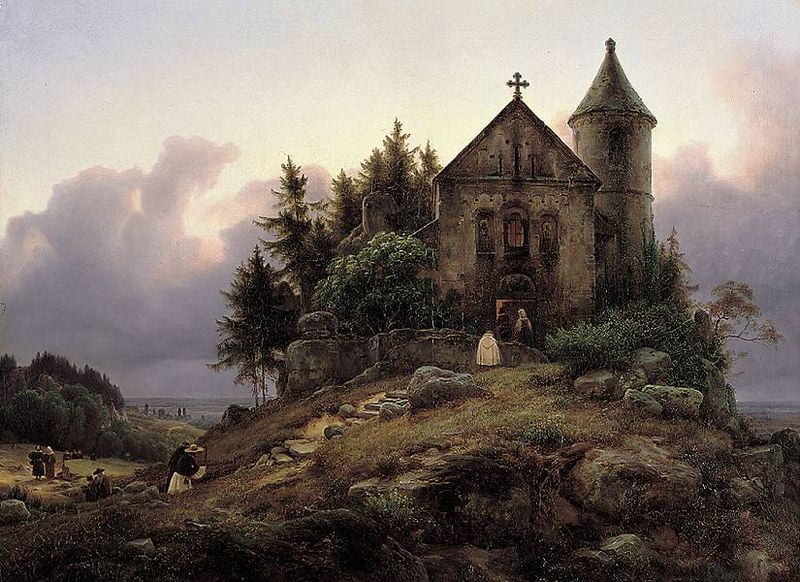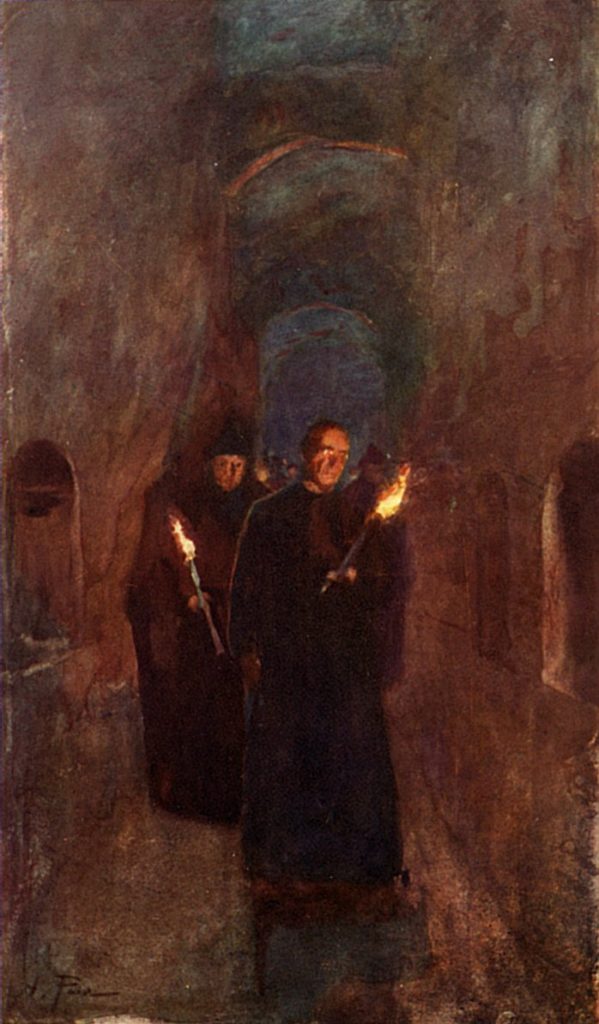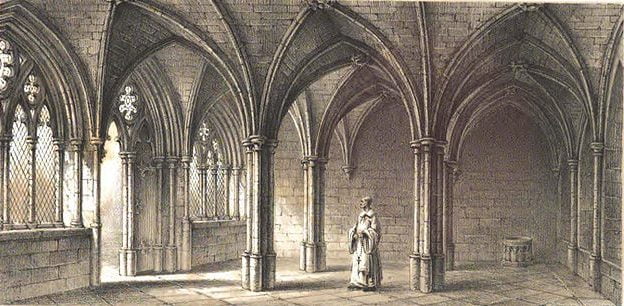Chapterhouses

Author Alejandro Melchor
Series Quintessential Series
Publisher Mongoose Publishing
Publish date 2002
A chapterhouse can be a paladin order’s main headquarters or, if it is large enough, the home of one of its branches. In any case, they have the same elements; what varies is the size and number of structures.
To design a chapterhouse, you can use the basic keep or castle in the SRD, or the rules for strongholds and temples in The Quintessential Fighter and The Quintessential Cleric,
which include more structure types. A summary of the construction rules follows:
† Building in difficult terrain such as a swamp, mountains or desert doubles the costs to represent the difficulty of working and carrying goods and materials.
† Constructions may be built larger than the base size listed. Doubling a single dimension (height, width or length) will double the cost, and tripling it will also triple the cost. The cost of increasing a dimension after increasing another applies to the new cost; for example, a gatehouse doubled in height to 40 feet would cost 16,000 gp, and if it is also doubled in width to 40 feet it would cost 32,000 gp. No dimension may be more than tripled in size, and no construction may be more than twice as high as its width.
† Buildings have structure points. One structure point equals 10 hit points of normal damage. Most siege weapons deal structure damage as well as hit point damage and
ignore the building’s hardness. Structure points increase in the same proportion as the construction’s cost for dimension increases. The gatehouse in the example would have 200 structure points after growing in height and 400 structure points after doubling its width.
† Constructions have a hardness of 8. Doubling the final cost increases this to 10.
† Prices in the Construction Lists include the costs of hiring and feeding workers, and an engineer must be hired for every 50,000 gp or part thereof spent on building the chapterhouse.
† The chapterhouse takes one week to construct for every 2,000 gp spent. This time can be reduced to one week for every 5,000 gp spent by increasing all costs by 50%.
The Keep

The central keep is the heart of the chapterhouse, where the rooms from which the order is run are housed. Some of the rooms may be in an outbuilding, but this is a matter of preference; most paladin orders are rather spartan in outlook and do not need anything fancier than a basic keep to fit their needs.
Round keeps, while more expensive and harder to build, are also more resistant to siege weaponry, its shape acting to deflect missile fire rather than resist it.
A chapterhouse keep has the following main room/areas:
Main Quarters: These are the habitations of masters and grand masters as well as the highest ranking knights. They are slightly larger than normal rooms and most decorations are trophies and banners. The extra room is usually a work space and/or oratorio where the paladins handle the order’s business and pray in private.
Member’s Cells: The rank and file of the order have their habitations close together. paladins of knight status have individual cells for themselves, with enough room to sleep comfortably and store their few belongings. Novices, acolytes and initiates are often bunked together in groups of four or more, or even in military-style barracks.
Staff ’s Quarters: Even when novices and initiates get clean-up duty all the time, the keep still needs nonpaladin staff to run it properly. These employees have their own wing in the keep, sometimes even their own building. They are treated with care and respect and many would never even dream of abandoning their service to the order, though they are not considered members and have no access to restricted areas.
Mess Hall: A chapterhouse will have one large room where the entire order gathers to share its meals. There may be other mess halls destined for the ordinary foot soldiers and staff, but it is the rule rather than the exception that the paladins allow their allies to eat with them in the same room.
Utility Rooms: From broom closets and food storage to kitchens and washrooms, chapterhouses have several utility rooms scattered along their corridors where their placement makes sense.
Chapel: paladins conduct their more common religious ceremonies in a dedicated chapel either inside the keep or in its own building if the order depends on a church. This chapel sees several ceremonies and events that outsiders may attend. It is also a meeting hall where masters and grand masters transmit their orders and other messages to the bulk of the order. In times of war or disaster, the chapel also doubles as improvised living space for refugees.
Infirmary: Near the chapel, the chapterhouse has its own infirmary when the ill and the wounded rest and recover. There is always a cleric on call as well as a rotating number of paladins doing their part to ease their fellow’s suffering. Thanks to the paladin’s healing talents, the infirmary is seldom full.
Secret Meeting Hall: Hidden behind locked and secret doors, through mazes or dark corridors, the secret meeting hall is where the order conducts its real business, away
from the eyes of outsiders. It is here that initiations take place as well as induction into higher ranks, and where the grand master speaks with the order’s patron. This is a holy place, usually protected by powerful wards and divine magic that prevent anyone from spying or dropping by unannounced.
Catacombs: paladins bury their own beneath the chapterhouse’s grounds. In ever-expanding corridors lie the bodies of fallen warriors, with the remains of great heroes
having their own locked crypts. Many catacombs are also the access points to the secret meeting hall or other secret vaults that the order maintains.
Training Grounds: There are several kinds of training grounds in a paladin order’s chapterhouse. From the open courtyards necessary for melee and ranged weapon training to tracks and lanes for Mounted Combat training. Although it would make sense to hire a necromancer to raise undead in order to train paladins in their ability to channel positive energy, association with such foul practices is a violation of most of what paladins believe in.
Walls and Defences: Depending on its location, a chapterhouse may have the same defences as a military fortress. For chapterhouses deep in civilised – and allied
– territory such defences are not necessary, but those in the frontier and specifically built to guard and protect an area can have high walls, moats, towers, bastions, gatehouses and siege weapon placements, accessible barracks and armouries, etc.
| Construction List | |||||
| Construction | Cost | Height | Width | Length | Structure Points |
| Catacomb | 300 gp | 10 ft. | 10 ft. | 10 ft. – | |
| Gatehouse | 8,000 gp | 20 ft. | 20 ft. | 50 ft. | 100 |
| Keep, Round | 120,000 gp | 80 ft. | 40 ft. | 40 ft. | 1,250 |
| Keep, Square | 80,000 gp | 80 ft. | 40 ft. | 40 ft. | 1,000 |
| Moat | 500 gp | 20 ft. | 20 ft. | 100 ft. | – |
| Outbuilding, stone | 900 gp | 10 ft. | 20 ft. | 20 ft. | 12 |
| Outbuilding, wood | 600 gp | 10 ft. | 20 ft. | 20 ft. | 8 |
| Stables, special | 10,800 gp | 20 ft. | 40 ft. | 60 ft. | 160 |
| Stables, exotic | 2,500 gp | 20 ft. | 20 ft. | 20 ft. | 30 |
| Tower, round | 25,000 gp | 30 ft. | 20 ft. | 20 ft. | 800 |
| Tower, square | 18,000 gp | 30 ft. | 20 ft. | 20 ft. | 600 |
| Underground corridor | 150 gp | 10 ft. | 5 ft. | 5 ft. | – |
| Vault, library* | 44,170 gp | 20 ft. | 40 ft. | 40 ft. | – |
| Vault, armoury* | 36,370 gp | 10 ft. | 20 ft. | 30 ft. | – |
| Vault, sanctum* | 37,270 gp | 10 ft. | 30 ft. | 30 ft. | – |
| Wall | 4,000 gp | 20 ft. | 20 ft. | 100 ft. | – |
Other Structures
The following structures fulfil a paladin order’s needs and are not found outside a chapterhouse. While other buildings may have their own version of a secret chamber, the ones in a chapterhouse perform very order-centric functions.
Secret Vault: A paladin order, especially one dedicated to preserving knowledge and safeguarding artifacts and relics, has one or more secret vaults hidden somewhere inside the complex, most often in one level of the catacombs or at the heart of the keep, accessible through very limited – and heavily guarded – entrances. The main types of secret vaults are the library, the sanctum and the armoury.
† Secret libraries are where the order keeps its most holy of books, or magic books deemed too dangerous to be out in the open. The scroll collection is composed almost purely of divine magic, but arcane scrolls and spellbooks find their way here if they belonged to evil casters that the order had defeated in the past. Also found here are secret documents and records of the order’s activities and histories that the grand masters judge that are too sensitive to be outside in the main library.
† Secret sanctums are special places of worship. Here, masters and grand masters enact powerful rituals with allied clerics, asking for divine guidance, individual paladins take world-shaking oaths and the most secret of the order’s ceremonies are held. This space also serves as storage and protection for powerful magic items of divine nature and, in some cases, it can also be a prison or containment for an evil being or artefact that the order has sworn to protect from falling into the wrong hands.
† Secret armouries can be confused with sanctums, but their sole purpose is to safeguard weapons. Magical weapons and armour are kept apart from the order’s normal armoury. More people have access to this vault, as paladins in the order are rewarded with magical equipment for extraordinary deeds and good service. The secret armoury can also be the place where divine crafters enchant weapons especially for the order.
These secret vaults are protected by spells and traps, which are taken into account in the listed cost. All vaults have a permanent magic circle effect that wards them from
chaotic and evil forces as well as nondetection to prevent scrying and dimensional anchor to prevent dimensional travel into the vault.
Special Stables: Apart from the stables for pack animals and the normal soldier’s horses, there are special stables set apart from the magical beasts that the paladins ride. These stables are fancier and provide the mounts with more space and accommodation. They are also better built and guarded against attack, even if the intelligent warhorses are perfectly capable of defending themselves.
One special stable holds up to 6 special mounts of Large size, although one stall could be outfitted to accommodate two Medium-size mounts.
Exotic Stables: Some paladin orders encourage or even specialise in exotic mounts, and keep small stables and facilities for them. Flying mounts such as pegasi and griffons have aeries upon the roofs and towers of the keep, while dire beasts and other grounded mounts usually have their own special stable. The listed cost is for a stable for one exotic mount and includes the special requirements and construction for such an unusual stable.
* Includes the cost of magical protection.
Staff

The details of the architecture match modern scholarship, however the artist has left out the furnishings for sake of clarity. The small font in the corner is fanciful.
1848 Architectural views and details of Netley Abbey, by George Guillaume
Paladins do not handle all of the chores that keep a chapterhouse running, but employ several people usually provided by an allied church or hired by their own efforts. Masters of the order screen any new staff member so as not to allow any person of chaotic or evil alignment (and the evil ones are watched closely after they are turned away).
The following are 1st or 2nd level experts in their fields, and the salary per month includes lesser staff such as stable hands under the stable master, scullery boys for the cook, etc.
Staff members are not fully part of the order, and the insignia that guardsmen and foot soldiers wear is an indication of their station as retainers.
Alchemist: A specialist in brewing concoctions and superior equipment. Sometimes contributes to sacred rituals, especially burials in the catacombs.
Armourer: A smith who crafts and maintains the armour of the chapterhouse’s warriors, including the paladins. One armourer is needed for every 100 armed men.
Beast master: This specialist knows how to care for a single type of exotic mount. A single beast master can care for six creatures of the species he is familiar with, but if the chapterhouse includes more than one type of exotic mount, additional beast masters must be hired.
| Staff List | |
| Staff Member | Cost per Month |
| Alchemist | 800 gp |
| Armourer | 125 gp |
| Beast Master | 100 gp |
| Captain of the Guard | 2,000 gp |
| Castellan | 500 gp |
| Chamberlain | 50 gp |
| Cook | 5 gp |
| Engineer | 500 gp |
| Foot soldier | 5 gp |
| Guardsman | 10 gp |
| Librarian | 25 gp |
| Mount Handler | 30 gp |
| Sacristan | 15 gp |
| Sage | 1,000 gp |
| Siege Engineer | 100 gp |
| Stable Master | 10 gp |
| Weaponsmith | 100 gp |
Captain of the Guard: The leader of the chapterhouse’s guards and foot soldiers, as well as the overseer of the defences. If he is a paladin member of the order, he does not charge a salary.
Castellan: The person responsible for the chapterhouse’s defences and only hired when the chapterhouse is in a dangerous zone or has built defences.
Chamberlain: The chamberlain runs the day-to-day affairs of the chapterhouse.
Cook: For every 50 persons living in the chapterhouse, a cook must be part of the staff.
Engineer: Apart from building the chapterhouse, an engineer is vital for keeping the structures in good shape. One engineer is needed for every 100,000 gp spent to build
the chapterhouse.
Foot soldier: Regular warriors that do not belong to the order, but provide a basic defence for the chapterhouse. Even the lowliest knight can be assigned to command groups of foot soldiers in battle.
Guardsman: A sentinel specially trained to keep an eye on his surroundings. A guardsman is more disciplined and better trained than a regular foot soldier.
Librarian: The person in charge of the order’s collection of books and records. A particularly trusted librarian may be in charge of the secret library, and earns triple the amount listed.
Mount Handler: The mount handler is better trained than the stable master, as he knows how to care for the paladins’ special warhorses. One mount handler can care for 10 special mounts.
Sacristan: The sacristan is responsible for keeping the chapel and other religious places in working order and good state.
Sage: An expert in tracking down and researching obscure knowledge. The paladin order hires such a person as they try to understand the nature of their
enemies better.
Siege Engineer: For chapterhouses who live under the constant threat of war, a siege engineer is in charge of a single catapult, trebuchet or other siege weapon that helps in the chapterhouse’s defence.
Stable Master: This person is responsible for the care of all normal mounts and animals in the chapterhouse. One stable master is needed for every 20 such creatures.
Weaponsmith: As vital as the armourer, the weaponsmith makes and cares for the weapons of the mundane and holy warriors in the chapterhouse. One weaponsmith is needed for every 100 armed men.

 Buy me a coffee
Buy me a coffee